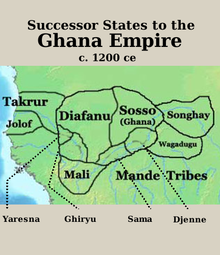Soumaoro Kanté: Difference between revisions
No edit summary |
m Reverted edits by 70.90.174.100 (talk) to last revision by ClueBot NG (HG) |
||
| Line 16: | Line 16: | ||
| ALTERNATIVE NAMES = |
| ALTERNATIVE NAMES = |
||
| SHORT DESCRIPTION = |
| SHORT DESCRIPTION = |
||
| DATE OF BIRTH = |
| DATE OF BIRTH = |
||
| PLACE OF BIRTH = |
| PLACE OF BIRTH = |
||
| DATE OF DEATH = |
| DATE OF DEATH = |
||
Revision as of 22:57, 1 March 2012

Soumaoro Kanté (var.: Sumanguru Kanté) was a thirteenth century king of the Sosso people. Seizing Koumbi Saleh, the capital of the recently-defunct Ghana Empire, Soumaoro Kanté proceeded to conquer several neighboring states, including the Mandinka people in what is now Mali. However, the Mandinka prince Sundiata Keita built a coalition of smaller kingdoms to oppose him at the Battle of Kirina (c. 1240), defeating the Sosso and leaving Sundiata's new Mali Empire dominant in the region.
Soumaoro Kanté is portrayed as a villainous sorcerer-king in the national epic of Mali, the Epic of Sundiata. After his defeat at Kirina, he flees into the mountains of Koulikoro, where he disappears after being shot with only weapon to which he is vulnerable - an arrow with a white rooster crest on it. In the Epic of Sundiata, Soumaoro Kanté is described as owning a balafon with magical powers, which is stolen by Sundiata Keita's djeli, Balafasseke Kouyate, and brought to Manden. This is the origin of the Manden djeli tradition of balafon playing. The balafon of Soumaoro Kanté is said to be kept by the Kouyate family to this day in the village of Niagassola in Guinea.
References
- Davidson, Basil. Africa in History. New York: Simon & Schuster, 1995.
- Charry, Eric. Mande Music: Traditional and Modern Music of the Maninka and Mandinka of Western Africa. Chicago: Chicago Studies in Ethnomusicology, 2000.
External links
- Sundiata and Mansa Musa on the Web web directory
